When the beau and I went honeymooning in Europe, we took pains to eat what the locals ate. Thus, we refused to eat at eateries that served American, Mexican, or Asian food in Europe. First, such food was virtually guaranteed not to be good. Second, we could spend our money and fill the limited space in our stomachs with something much better, authentic European food. However, we did make a few slip-ups. In Switzerland, one evening, at a restaurant called Raclette Stube, we ordered their meat fondue, expecting an authentic "Swiss" dish.

When the meal arrived to our table, we were disappointed to discover that the meat fondue (which cost around 40 Swiss francs a head) or "fondue chinois," was simply a version of steamboat hot pot that is served in every-Chinatown, USA.
But thankfully, there were unique Swiss additions to the Chinese fondue. There were (1) creamy fingerling potatoes steaming in a towel-wrapped wicker basket; (2) sweetly brined cornichons (gherkins), pearl onions, and baby corns with a vinegary bite; (3) crisp Swiss potato chips, and (4) a beautiful variety of mayonnaise and aioli dipping sauces made with curry, dijon, and horseradish.

In addition to these interesting Swiss additions, I noticed several differences between Swiss "fondue chinois" and the "fondue chinois" that I eat in America. The Swiss restaurant did not provide a bowl or spoon to enjoy the meat broth in the fondue pot (I merely was given a two-pronged fork) and there were no vegetables, seafood, noodles, or meatballs to cook alongside the thin slices of meat.

My Swiss hot pot experience drew me closer to my own previous hot pot experiences, and reminded me of how I enjoyed hot pot at home the most. Furthermore, because of my rigid, cheapskate upbringing, my wallet has always been uneasy about restaurant hot pot. (If you're unfamiliar with hot pot, see my previous post on hot pot, here, where I explain this soup meal that you cook in and eat from a communal pot. You cook the quick-cooking raw meats and vegetables in a boiling soup, and quickly remove them to prevent overcooking.) A part of me cannot get over the concept of going to a restaurant to cook your own meal. Hey, I pay for someone to do that for me, and that makes me feel special for the evening!
I earnestly believe that hot pot is best done at home. Communal cooking encourages real social collaboration. I love seeing how ambitious guests take charge and step up to the plate--err, I mean pot! Hot pot can also be as mesmerizing as a Broadway production, replete with swirling steam emanating upward from the boiling pot and sizzling and spitting burner grates. But by far, the best part about entertaining with hot pot is that you allow your guests do the work, rather than laboriously toiling away with your back hunched over relentless, sweltering, and glowing spiral burners. Thus, by serving hot pot, you avoid any burn marks branded on your fingers and a lot of stress!
For hot pot, you need a table top butane bunsen burner or electrical hot plate. A table top heating source is a great investment for a working entertainer because it can be used for cheese and chocolate fondue and Korean barbecue (use a grill pan such as a cast iron pan that will retain heat for grilling, though). Such a table top heat source is critical for keeping the food piping hot, as any good caterer will tell you.
Although the "one pot" cooking method isn't conducive for catering to the whims of finicky eaters, check out your local Chinatown for "divided hot pots," which allow you to heat multiple types of broth in the same gurgling cauldron. Each divided pot section may hold alternative soup bases such as (1) a light, refreshing, and cleansing broth or (2) a spicy, nasal-piercing, and magma-hued stock, seasoned with fiery chilies.
Simplicity prevails in hot pot preparation. Hot pot entails only (1) the making of a soup base, (2) the gathering together of ingredients for each person's dipping sauce, and (3) the cleaning and chopping the vegetables. Here are some suggested hot pot ingredients:
Stock Base - Lace your stock or broth base with the one or more of following pungent ingredients for a highly memorable flavor:
- Fresh Ginger (Bruised)
- Miso Paste
- Cumin Powder
- Dried Red Chilies (Whole or Powdered)
- Szechuan Peppercorns
- Star Anise
- Five Spice Powder
- Bonito Fish Flakes
- Dried Taro Strips
- Bay Leaves

Dipping Sauce - Allow guests to dip their meat and other cooked hot pot ingredients in a variety of sauces made of three or more of the following ingredients:
- Soy Sauce
- Sesame Oil
- Rice Wine Vinegar
- Honey
- Chicken Eggs
- Sa-Cha Jiang (Taiwanese Barbecue Sauce made of Anchovies)
- Minced Garlic
- Sliced Scallions
- Chopped Cilantro
- Ground Sesame Paste (Japanese Goma)
- Ponzu Sauce
- Mayonnaise (Flavored with Curry Powder, Horseradish, or Dijon Mustard, in the Swiss Meat Fondue-Style)
 Ingredients List - Next, the following ingredients should be the primary substance in your hot pot meal. Feel free to add:
Ingredients List - Next, the following ingredients should be the primary substance in your hot pot meal. Feel free to add:
- Thinly Sliced Daikon Radish
- Thinly Sliced Carrots
- Shiitake Mushrooms
- Enoki Mushrooms
- Straw Mushrooms (Canned)
- Soft Tofu (Blocks or Skin)
- Cellophane Mung Bean Noodles (Individual Bundles)
- Yam Noodles (Individually Self-Tied Bundles)
- Udon Noodles
- Shell-On Shrimp (Fresh or Dried)
- Squid
- Springy Precooked Asian Meatballs (Shrimp, Squid, Fish, Beef, Pork)
- Thinly Sliced Meat (Beef, Lamb, Goat, Pork, Chicken)
- Leafy Vegetable Greens (Napa Cabbage, Chrysanthemum Greens, Spinach)
- Frozen Dumplings or Wontons

In the end, after assembling the ingredients and watching your guests cook their (and your meal) you should be greeted with a rich caramel brown-colored broth surrounded by tender sheets of thinly sliced meat (such as rib-eye) poached until small meat ridges have peaked and the edges have curled. With those visual meat cues, the meat is done and the guests are now free to steep their meat and vegetables in a sweetened soy marinade, and shower their hot pot meal with a generous helping of angular scallions sliced on a bias.

Depending on your other ingredients, you and your guests might also enjoy crisp patches of nori (seaweed paper) which become absorbent floating blankets, wispy tendrils of poached egg, smooth-skinned dumplings with soft and uniform pleats, or circular curls of pinkened shrimp.

So to review, here's the game plan for hot pot:
Step #1 Prepare ample amounts of broth ahead of time and keep it on a low simmer during food preparation. Keep a large stockpot simmering on the range and keep refilling the table top pot with the liquid contents of the large stockpot, as you run low on soup on the table top pot.
Step #2 Defrost the meat and seafood (if frozen). When purchasing meat for hot pot, look for meat with thick white segments of fat encompassing the edges or interspersed in the meat like gargantuan continents (in a meat map of the world). The more fat, the more luscious and rich the flavor of the soup and tender the meat.

Step #3 Prepare the vegetables and tofu by (1) washing and leafing the greens, (2) peeling and slicing the daikon and carrots, (3) chopping the garlic, cilantro, and scallions, and (4) dicing the tofu into bite-sized blocks.

Step #4 Lay out the ingredients for the sauces.
Step #5 Set up the bowls, chopsticks, soup spoons, and spider ladles or regular ladles. For a cute touch, you can even label the different plates of meat and place settings (to give the guests a sense of ownership during their hot pot cooking process). They choose what meats go in, and when, so hot pot is definitely "cooked" by your guests.

Step #6 During your hot pot dinner, give verbal instructions to the guests to move the cooked pieces of meat to a specified, cooler area of the pot, or another "serving" bowl entirely, to prevent cross-contamination. Also provide multiple sets of metal scalloped-edged tongs (or spider strainers, which can be purchased in a Chinatown near you), to be sure that no one person monopolizes the hot pot and to allow each of the guests to be equally involved in cooking.
Finally, some hot pot fanatics say that it is a "must" to have ready-made foods at the guests' immediate disposal because of the lag time of cooking hot pot. Therefore, following the Korean and Swiss traditions, you may offer multiple "pickled" side dishes (panchan) with your hot pot, none of which need to be prepared from scratch. Buy canned or jarred preserved vegetables, or think about frozen and microwavable versions of steamed buns. You can even order side dishes to go! But I think the pickled additions are the way to go, since they lend a palatable and acerbic crispness and pleasant vinegar tartness to accompany the warm and soothing hot pot soup. And the pickles are addictive and delicious little snacks easily pinched between the tapered ends of a pair of lengthened and slender chopsticks. Now, I am not one who generally extols the virtues of premade goods, but as an entertainer, you'll need as much assistance you can get, and if the assistance is from factory laborers or automated, mass-producing, pre-packaging food machinery, so be it!
The only drawback of hot pot is the multiple dishes that you'll need to wash after the night is through. The upside however, is that you will have amassed a plentiful collection of petite, shatterprone dishes, although disposal ware should do.
Hope these hot pot tips helped, or at least inspired you do have a hot pot party for your friends in the future!
It's not, "I love you."
Nor is it, "I adore you."
It isn't even, "You da' man."
Rather, it is "Monterey Park Food," which can be found at a three-word restaurant, "Mandarin Noodle House."
For those of you unfamiliar with Monterey Park, it is home to one of the largest ethnic Taiwanese enclaves in the United States. My beau (a Taiwanese man) calls Monterey Park the "promised land" because of its authentic and affordable Chinese/Taiwanese food. Therefore, for a friend's recent wedding (after the back-to-back scheduled events of the rehearsal, rehearsal dinner, and wedding) we snuck away to Mandarin Noodle House, a typical Monterey Park establishment, right before zooming off to LAX for the long trek back home.
There are several classic "must have" items at Mandarin Noodle House.
First, their Chinese beef noodle soup, or niu row mein, is one such "must have." The soup is made with thick and gummy handmade fettuccine-like noodles, and enlivened with bright and zesty cilantro sprigs and coarsely chopped scallions. The warm soup is powered by a rich broth and the cutting flavors of star anise and cinnamon. And the slow-cooked beef is fall-off-the-bone tender--even though there is no bone for it to fall off from.


Look at these handmade noodles!

And their potstickers are almost as good as how my mom makes them.

The key word in that sentence: "almost."
The doughy skins of Mandarin Noodle House's potstickers gingerly hold together the pork filling, and the bottoms of the potstickers are seared in a hot skillet, until the bottom portion of the dough forms a thin, crisp crust.

I recommend for you to try those two dishes, but if you are trying out a Chinese/Taiwanese restaurant, you should also explore other options, such as these beef-filled rolls with sweet hoisin sauce, cilantro, and scallions. Let me warn you, you won't find any items like "chop suey," "General Tso's Chicken," or "sweet and sour pork" on the menus of restaurants like these.

Hey, I'm on a roll (pun not intended), so I might as well add a few words about another restaurant to which my beau and Short Exact introduced me a while back, "Shanghai Dumpling King." Shanghai Dumpling King, which is conveniently also three words, serves classic Chinese/Taiwanese-style dishes. You can also get potstickers, pan-fried scallion flatbreads (awkwardly translated in Chinese restaurants as green onion pancakes), and great beef noodle soup there too. However, the only thing is that Shanghai Dumpling King is in the Bay Area, not in Monterey Park! I just wanted to mention it, to point out another critical item to order at a good Chinese/Taiwanese restaurant: shao loeng baos, which are steamed dumplings with ground pork and hot pork broth precariously sealed inside of them.

If looks could kill, I would be D.O.A. at these restaurants.
Unfortunately, after my own cursory hunting, I was unable to find any authentic Chinese/Taiwanese restaurants in the Greater New Orleans area, but if you know of any off the beaten path, please share the love!
I hope that this post opened your eyes about Chinese/Taiwanese food, and has encouraged you to try some in your area, in the near future!
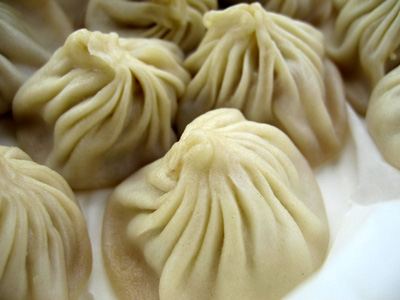 For my annual Thanksgiving pilgrimage down to Southern California, I was compelled by the force (of my growling stomach) to make a necessary pit stop at the Arcadia location of the famed Din Tai Fung chain restaurant from Taiwan. Din Tai Fung produces the perfect dough-wrapped, meat-filled packages, packages that are aptly known in Chinese as "shao loeng baos."
For my annual Thanksgiving pilgrimage down to Southern California, I was compelled by the force (of my growling stomach) to make a necessary pit stop at the Arcadia location of the famed Din Tai Fung chain restaurant from Taiwan. Din Tai Fung produces the perfect dough-wrapped, meat-filled packages, packages that are aptly known in Chinese as "shao loeng baos."
Joe's Shanghai in Flushing, New York, you ain’t got nuthin' on these Taiwanese chain-restaurant babies.
That Din Tai Fung's soup dumplings run out within an hour of opening (and that they only sell soup dumplings on the weekends) is an indicator of how good this place is.
You can't miss Din Tai Fung. You'll see a line of pushy patrons snaking around the insides of a strip mall, and like me, their eyes will be bright with "visions of steaming shao loeng baos dancing in their heads."
My favorite part of Din Tai Fung is not the dumplings themselves, but the ability to watch the entire production. When patrons enter the restaurant, they are allowed a bird’s-eye view of how Din Tai Fung’s dumplings are made. Immaculately-cleaned, thick, and soundproof glass windows enclose the dumpling-making area and allow patrons to peer at the assembly-line.
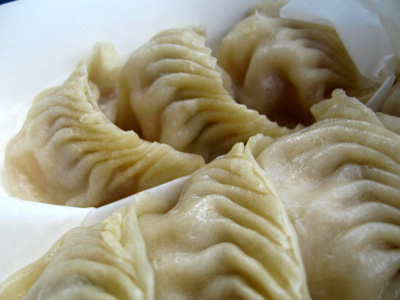 The dumpling makers work in a rapid-fire sequence of coordinated movements. Worker #1 rolls tight, flour-dusted dough balls into thin, flat, and circular dumpling wrappers. He does this by efficiently moving a wooden rolling pin over the dough using his right palm and simultaneously twisting his left wrist to quickly rotate the wrapper in a counterclockwise motion. Worker #2 then pats a round meatball-sized circle of ground pork onto the wrapper using a flattened wooden dowel specially used to portion the perfect amount of meat into the dumpling. Worker #3 then manually folds mini-pleats into the perimeter edges of the dumpling wrapper and squeezes the wrapper over the meat to form either a crescent moon-shaped dumpling or a beggar’s bag-shaped dumpling.
The dumpling makers work in a rapid-fire sequence of coordinated movements. Worker #1 rolls tight, flour-dusted dough balls into thin, flat, and circular dumpling wrappers. He does this by efficiently moving a wooden rolling pin over the dough using his right palm and simultaneously twisting his left wrist to quickly rotate the wrapper in a counterclockwise motion. Worker #2 then pats a round meatball-sized circle of ground pork onto the wrapper using a flattened wooden dowel specially used to portion the perfect amount of meat into the dumpling. Worker #3 then manually folds mini-pleats into the perimeter edges of the dumpling wrapper and squeezes the wrapper over the meat to form either a crescent moon-shaped dumpling or a beggar’s bag-shaped dumpling.
Just talking about the dumpling-making process has gotten me in the mood for these dumplings. Even if you don't live nearby any location of Din Tai Fung, I highly encourage you to try these perfect and juicy packages this holiday season!

 Eggs are one of the easiest and quickest working eater foods out in the market today. There are no preservatives, no microwaves, and no can openers to deal with. Plus, kids generally like eggs too! You can't go wrong with them.
Eggs are one of the easiest and quickest working eater foods out in the market today. There are no preservatives, no microwaves, and no can openers to deal with. Plus, kids generally like eggs too! You can't go wrong with them.
With that in mind, I want to share a newly-discovered working eater recipe for Taiwanese oyster omelets! (I learned how to make this for my beau, who loves oysters and Taiwanese food.) I was inspired to write up a recipe for this dish for the working eater series because of Elmo Monster's post on a Taiwanese restaurant that served this seafood omelet. It literally takes minutes to make, thus making for a wonderful main dish for a working eater.
Taiwanese Oyster Omelet
10 oz jar of refrigerated shucked oysters, drained and roughly chopped
1/4 cup powdered sweet potato starch
1/2 cup water
2 tbsp sweet chili sauce (can substitute 1 tbsp of sriracha thoroughly mixed with 1 tbsp of ketchup)
3 large eggs, scrambled
2 tbsp of vegetable oil (divided)
1 cup of cooked chrysanthemum greens, stir-fried with 2 cloves of chopped garlic (can substitute mustard greens or spinach for the chrysanthemum greens)
Combine the sweet potato starch, water, and oysters until thoroughly blended. Heat 1 tbsp of the oil in a wok or large skillet until shimmering, and pour the starch batter in the skillet and allow it to cook and set until it begins to turn translucent. Flip the sweet potato starch pancake until it becomes translucent throughout. (You may have to break the sticky pancake up into more manageable patches, and individually flip each patch.) The pancake should have a gluey texture, almost like mochi. Now, take the cooked pancake off the heat, and reserve.
Using the same pan (first, make sure that the surface is clean and unblemished with leftover potato starch bits), add the remaining tbsp of oil, and heat until shimmering. Swirl the scrambled egg mixture into the heated pan. Being careful not to break the egg omelet, heat it until it is set, and carefully flip it, using a wide-brimmed spatula if necessary.
There are two ways to serve the omelet. You can either spread the bed of greens and cooked potato starch mixture on one-half of the omelet (while it is still in the pan) and flip it onto a plate, or put the greens and potato starch mixture directly on the plate, and put the full, circular omelet on top. Either way, spread the hot sauce on the surface of the scrambled omelet, and enjoy!
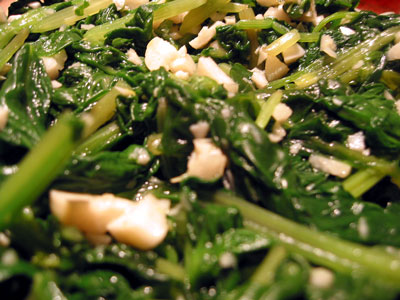 The fluffy egg omelet is a perfect companion to the crunchy and wilted wisps of chrysanthemum greens, the sweet pungency of the fiery pepper sauce, the sticky potato starch pancake, and the tender and chewy morsels of oyster.
The fluffy egg omelet is a perfect companion to the crunchy and wilted wisps of chrysanthemum greens, the sweet pungency of the fiery pepper sauce, the sticky potato starch pancake, and the tender and chewy morsels of oyster.
In celebration of me finishing my language course at the Adult School, I am going to post on the blog!Disturbing Story of the Week: My friend and I were walking along one of the piers on the Embarcadero this afternoon, and we decided to walk to this little "immigrant fishing corner" that is hidden about a block away from the Ferry Building. As we walked by the immigrant fishermen and their catch, we saw medium-sized fishes that were about a foot in length and that looked pretty interesting with these weird psychadelic colors on their scales. (I don't know whether those colors had to do with the "super-fund" pollutants and toxic seepage in the Bay or what.) These fish were just plopped and strewn about on the sidewalk. They weren't even stored in a bucket or an insulated cooler. Just "splatted" on the bare concrete sidewalk.My friend and I were looking at all the fish as we were strolling down the pier, when suddenly, we saw this tremendous sea creature the size of an adult leg. It was moving its jaw around slowly and had these huge bloody gashes in the sides of its spotted pale gray skin. My friend and I squealed in horror, and my friend asked the fisherman what kind of fish it was. As we were shuddering and shrieking like little girls, the elderly Chinese fisherman-guy grimaced at us like we were mental ward escapees and said, "Shark." He then jerked his hand around as if to tell us to get the heck outta there and quit bothering him.I guess it's not that big of a deal, but I am just amazed that someone could catch a shark on all by their lonesome and not be worried of death or injury. Plus, the shark was in bad shape, and I felt sad for it. What compelled this guy to keep this battered and abused shark and not throw in back in the water, the world will never know.Pretty disturbing. But, actually, it wasn't the most disturbing thing I saw that day. I also watched an Indie film (that was depressing to the point that it made me want commit suicide afterwards) and some random guy shooting a gun in the air. Freakin' creepy. I love San Francisco...I know, I've been a lazy piece of crap lately in terms of updating my blog, but I've honestly been working on two posts that spiraled out of hand--I have five pages worth of text now that needs to be cut down. Till I cut those posts down to size, feast your eyes of some grainy cell phone shots of "oil sticks," or Chinese donut fried-fritters, a warm bowl of beef noodle soup, and chicken curry. I miss everyone, and hope to be posting again soon!

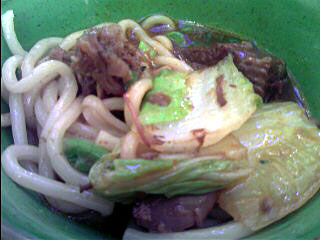
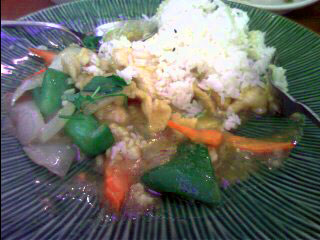




 Ingredients List - Next, the following ingredients should be the primary substance in your hot pot meal. Feel free to add:
Ingredients List - Next, the following ingredients should be the primary substance in your hot pot meal. Feel free to add:













